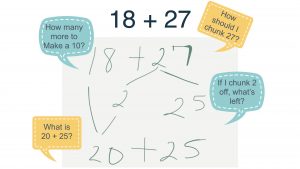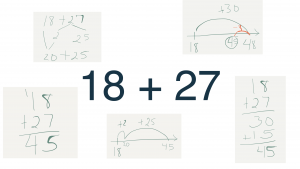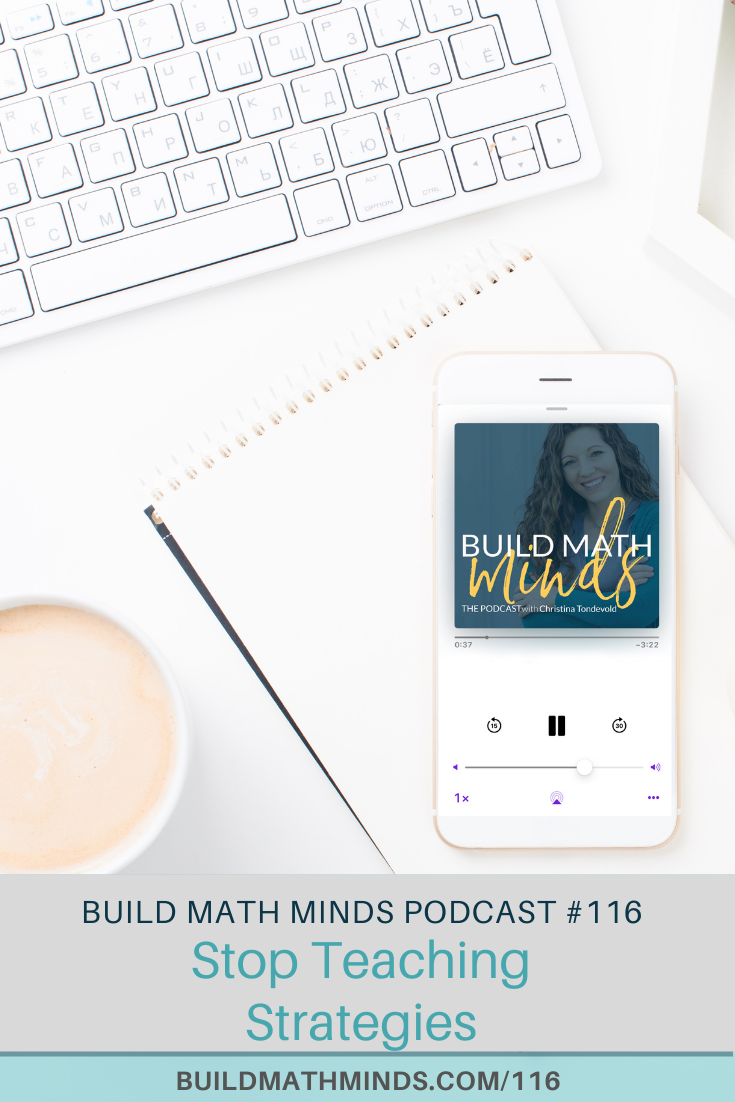Resources mentioned in this episode:
Webinar replay (only available through Oct 11)
Welcome fellow Recovering Traditionalists to Episode 116. Today you get to hear my thoughts on why we need to Stop Teaching Strategies.
Last weekend, I did a webinar about the missing piece to elementary fact fluency. And in that webinar, I kind of went off about how textbooks have us teach all these different strategies to kids. It’s something I’m very passionate about. And so I thought I’d share a clip of that part of the webinar with you in today’s episode. Some of the things I share in this clip are visuals of how textbooks teach kids to solve a problem like 18+27.
Also, if you miss the live webinar, you might just be in luck, depending upon when you are listening to this episode. If you are listening to the day it comes out, then you’ve still got a little bit of time to watch the replay before it gets taken down tomorrow. Head on over to buildmathminds.com/replay if you want to go watch it. For those of you who are Build Math Minds members, the recording of the webinar is inside the Build Math Minds PD site, so you have access to it inside the free trainings area of the PD site.
Okay. Here is the rant that I went off on in this last weekend’s webinar.
So the big root of this issue. Yeah, we want kids to have strategies, but the problem is, you can’t teach it. You cannot teach those strategies to kids because if you try to teach it, it just becomes another rule and procedure to memorize. And now they’ve got six different ways that they have to remember and memorize, and then each just becomes confusing. Every stinking textbook out there is doing it now, and it needs to stop. Right? You cannot directly teach these to kids. I could teach them, take two, give it to the 18 blah, blah, blah. But there’s so much that kids need to know, think about everything that you need to know to be able to do just this one strategy.


18+27 we try to teach kids to make it friendly, right? So I’m going to take off 2, bring it over. I’m going to, but I got to know why should I take… How do I know to take off 2? Well, it’s how many of it’s going to make a 10, right? So once I chunk off the 2, do I know how many is left? And then once I get 20 and 25, do I actually know what 20 and 25 is? And that’s just one strategy, but our textbooks are teaching kids all these strategies.

So time to stop. Stop teaching the strategies. If we teach the strategies and I’m not talking about just the multi-digit stuff either, it happens even with single digit stuff. We’re teaching kids all these different strategies for single digit addition, single digit subtraction, right? They end up looking like a deer in headlights. I live in the country. I see this all the time. Those of you who don’t know that phrase, when a deer jumps out in front of your car and sees the headlights, they freeze. Even though a car is coming at them, they don’t know which way to go. That’s what our students are like right now. They’re learning all these different strategies and they don’t know which way to go. And you can tell them, just pick whichever one you want. They don’t know which one to use. You’ve shown… We’ve shown them all these ways to do it.
And they don’t know which one to do. So your action item number two is stop teaching strategies. Now hold up a second. I want to make sure you’re hearing me, because I love strategies. I use strategies. I want my kiddos to use strategies. The problem is we’re trying to teach them. We’re teaching and, we’re directly teaching these strategies and it becomes confusing. Let your students solve it in a way that makes sense to them. Now, how do we help them make sense of strategies? Because remember, I love strategies. Kids need strategies, but you can’t directly teach strategies. They are not taught, they are caught. Kids catch strategies when they have developed their flexibility.

And again, I’m not saying we don’t want kids to have these strategies. We want kids to have strategies, but the problem is they don’t have a flexible understanding of numbers to be able to understand the strategies. Okay. So how do we actually help with that? How do we build that flexibility? The root of flexibility is kids’ number sense. We have to focus on building number sense.
If you want to learn more about how to develop students’ flexibility with numbers in the webinar. I get started on how to do that, but that is also what my online PD courses go deep into. The Flexibility Formula courses give elementary educators everything they need to help students build their flexibility with numbers. And the byproduct of that is students develop strategies on their own. You can go to buildmathminds.com/enroll to learn more and get registered for a course.
Registration is only open for a limited time, so go check it out now, before it closes.
Subscribe and Review in iTunes
Hey, are you subscribed to the Build Math Minds Podcast, yet? If you’re not, make sure to do that today because I don’t want you to miss any episodes! Click here to subscribe to the podcast in iTunes.
While you’re there, don’t forget to leave a review on iTunes too. I would love to know your thoughts and how we can make sure that we give you content that you will really enjoy.
To leave a review, head over to iTunes and click on “Ratings and Reviews” and “Write a Review.” I can’t wait to hear your thoughts about the podcast.




